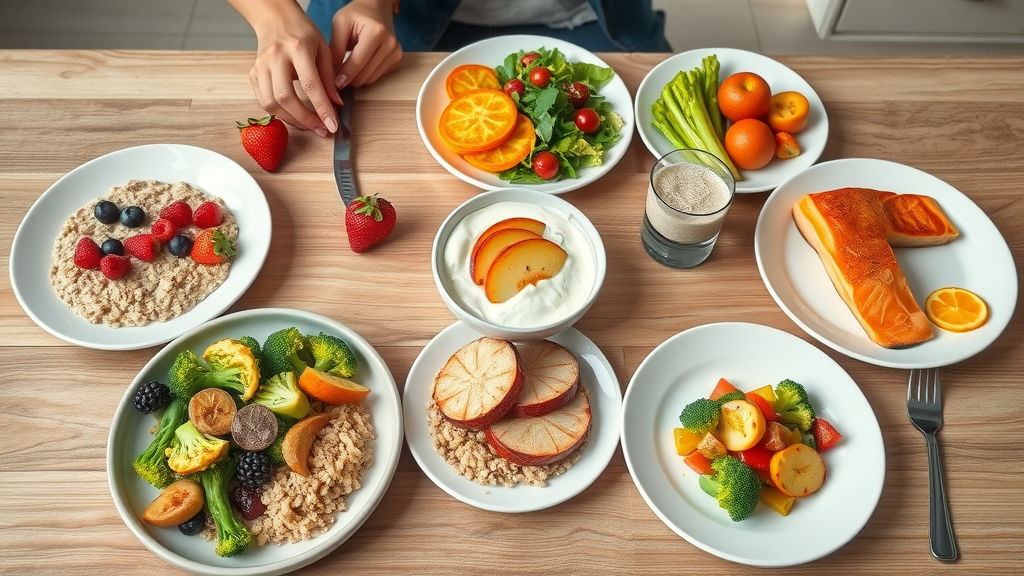Did you know: As we get older, nutrition becomes one of the most important keys to feeling vital, independent, and happy. In fact, making smart choices about what you eat can boost your energy, protect your mind, and add years of better living to your life. This article unlocks the surprising facts, practical guidance, and essential strategies for mastering nutrition for older adults —so you or your loved ones can eat smart and feel truly great every day.

Startling Nutrition Facts: Why Nutrition for Older Adults Is Crucial
"Did you know that nearly 60% of older adults are at risk of malnutrition, impacting not only physical health but cognitive function and quality of life? Making smart dietary choices can add years and vitality to your life!"
As we age, nutrition for older adults becomes more than just a means to satisfy hunger—it’s essential for maintaining independence, fighting chronic disease, and enjoying day-to-day well-being. The numbers are eye-opening: a significant portion of the older adult population fails to meet basic dietary guidelines, creating a cascade of health challenges. Malnutrition can strike anyone, but older adults are particularly vulnerable due to changes in metabolism, appetite, and even taste sensitivity.
Poor nutrition in this age group is linked to higher rates of muscle loss, frailty, and chronic diseases such as heart disease and diabetes. Understanding why certain nutrients become more important, how dietary guidelines shift, and what practical steps you can take will empower you to make food choices that really matter. Addressing nutrition for older adults helps reduce the risk of illness and supports sharper thinking, stronger bones, and greater enjoyment of life’s everyday activities.
What You'll Learn About Nutrition for Older Adults
- Understand updated dietary guidelines for older adults
- Learn how to read nutrition facts labels with confidence
- Discover the best foods for healthy eating after age 60
- Identify nutrients crucial for older adult health
- Find practical tips to improve meal planning and grocery shopping
Understanding Nutrition for Older Adults: Key Concepts and Dietary Guidelines
Why Nutrition Changes with Age for Older Adults
The body’s needs shift profoundly with age. For older adults, changes such as slower metabolism, reduced muscle mass, and altered absorption of essential nutrients mean that the same eating patterns from earlier decades may no longer support optimal health. Muscle mass naturally declines after 50, leading to an increased risk of falls and less physical activity. In addition, medications, dental changes, and health conditions can affect appetite, digestion, and the ability to enjoy a wide variety of foods.
Furthermore, taste buds lose sensitivity, so foods may seem less flavorful, making it tempting to increase salt or sugar—or skip meals altogether. For this age group, getting the right balance of protein, vitamins, and minerals while keeping calories in check is essential. Focusing on nutrient-dense foods rather than calorie-dense options becomes crucial for older adults to support immune function, cognitive health, and everyday mobility.

Dietary Guidelines for Americans: The Foundation of Healthy Eating for Older Adults
The Dietary Guidelines for Americans offer evidence-based recommendations for every stage of life, but when it comes to older adults, there are special considerations. Key federal government agencies in the United States update these guidelines every five years, reflecting the latest research on how nutrition affects aging. For those over 60, the focus is on achieving a healthy eating pattern that limits added sugars and saturated fat while promoting whole grains, fruits, vegetables, lean protein, and low-fat dairy.
Older adults have increased needs for certain nutrients—such as calcium and vitamin D for bone strength, as well as protein to maintain muscle mass—and may need to monitor other nutrients like sodium to help prevent hypertension. The table below summarizes the most important nutrients and recommended daily intakes for this age group:
| Nutrient | Recommended Intake for Older Adults | Top Food Sources |
|---|---|---|
| Protein | 1-1.2g/kg body weight | Lean meats, eggs, dairy, legumes |
| Calcium | 1200 mg/day | Milk, yogurt, cheese, leafy greens |
| Vitamin D | 800 IU/day | Fatty fish, fortified dairy, sunlight |
| Fiber | 21-30g/day | Whole grains, fruit, vegetables, legumes |
| Potassium | 3400 mg/day (men)/ 2600 mg/day (women) | Bananas, potatoes, beans |
Following these dietary guidelines can reduce the risk of chronic disease and improve quality of life, making them a cornerstone of healthy eating for older adults.
Reading the Nutrition Facts Label: Empower Older Adults to Make Healthy Choices
How to Decode Serving Size, Saturated Fat, and Added Sugars
"Understanding the nutrition facts label can be a game-changer for older adults seeking to control their saturated fat and added sugar intake."
The nutrition facts label is your passport to better choices, but many older adults find it confusing. The key is to start with the serving size—this tells you how much of the product all the other numbers are referring to, and servings are often smaller than you’d expect. Next, look for saturated fat and added sugars: these should be kept as low as possible to protect heart health and reduce the risk of chronic disease. The facts label will also list sodium (limit this especially if you have high blood pressure) and dietary fiber (aim high for gut health).
- Check serving size for realistic portions
- Limit saturated fat to less than 10% of calories
- Scan for added sugars and keep them minimal
- Review sodium and dietary fiber amounts
By learning how to quickly scan and interpret the nutrition facts label, older adults can much more easily identify which foods fit into their healthy eating goals. It’s a simple habit that makes every trip to the grocery store more successful—and every meal a step toward feeling your best.

Healthy Eating Plans for Older Adults: Practical Strategies to Eat Healthy Every Day
Sample Day of Healthy Food Choices
Creating a well-balanced meal plan doesn’t have to be complicated. Here is a sample day of healthy eating using nutrient-dense foods that fit the dietary needs of most older adults. This plan is designed to maximize fiber, lean protein, and healthy fats, while keeping added sugar and saturated fat in check.
- Breakfast: Oatmeal with berries and nuts (fiber-rich, low added sugars)
- Lunch: Grilled chicken salad with mixed greens, tomatoes, olive oil vinaigrette
- Snack: Greek yogurt with sliced peaches
- Dinner: Baked salmon, quinoa, steamed broccoli
- Dessert: Fresh fruit salad
A varied and colorful day of eating provides the right balance of energy, vitamins, and minerals. Each meal highlights the importance of food choices that nourish both body and mind—setting the foundation for a healthy diet in your 60s, 70s, and beyond.

List of Nutrient-Dense Foods for Older Adults
When aiming to make every bite count, focus on incorporating these nutrient-dense foods regularly:
- Leafy green vegetables
- Berries
- Whole grains
- Low-fat dairy
- Lean protein (fish, poultry, legumes)
These options deliver more vitamins, minerals, and antioxidants with fewer empty calories—supporting heart health, brain function, and overall vitality.
Adapting Portion Sizes: Serving Size and Nutrition for Older Adults
How Serving Size Impacts Nutrition Facts and Healthy Eating
Understanding serving size is critical in maintaining a healthy eating pattern for older adults. As calorie needs decrease with age but nutrient needs remain high, it’s easy to overeat foods that are calorie-dense but not nutrient-rich, or to eat too little of what truly matters. Accurately measuring and sticking to the recommended serving size ensures you’re getting the nutrients you need without consuming excess calories, saturated fat, or added sugar.
Here is a visual guide to standard serving sizes for some common healthy foods, along with their calorie and saturated fat content, to make meal planning simpler:
| Food Item | Standard Serving Size | Calories | Saturated Fat (g) |
|---|---|---|---|
| Cooked oatmeal | 1 cup | 150 | 0.5 |
| Cooked chicken breast | 3 oz | 140 | 1.0 |
| Steamed broccoli | 1 cup | 60 | 0.1 |
| Low-fat yogurt | 6 oz | 100 | 1.5 |
"Older adults may need fewer calories, but nutrient needs remain high—focus on quality over quantity."
Practicing portion control is not about eating less—it’s about eating smart. Use smaller plates, measure portions when possible, and pay attention to hunger and fullness cues to help maintain a balanced dietary pattern that meets both energy and nutrition needs.

Guidelines for Americans: Managing Dietary Restrictions and Chronic Conditions with Nutrition for Older Adults
"Consult a healthcare provider or registered dietitian for personalized dietary guidelines if you manage conditions like hypertension, diabetes, or osteoporosis."
Many older adults face dietary restrictions due to chronic disease such as diabetes, heart disease, or osteoporosis. Adapting dietary guidelines thoughtfully is essential in these circumstances. For example, lowering sodium intake helps manage blood pressure, increasing calcium can support bone health, and tracking carbohydrates is important for those with diabetes. The guidelines for Americans recommend that anyone with special health considerations work closely with a health care provider or registered dietitian to tailor nutrition plans to individual needs.
These professionals can interpret nutrition facts, set serving size goals, and help you navigate sensitive information like added sugar and saturated fat in your favorite foods. Whether it’s reviewing ingredient lists or developing a dietary pattern that fits your lifestyle, the right support can empower older adults to eat healthy while managing chronic conditions.

People Also Ask: Expert Answers for Nutrition for Older Adults
What is the best nutrition for elderly people?
The best nutrition for elderly people means focusing on foods that are rich in essential nutrients like protein, calcium, fiber, and vitamins while limiting sodium, saturated fat, and added sugars. Following the dietary guidelines for Americans , older adults should prioritize fruits, vegetables, lean meats or plant proteins, whole grains, and low-fat dairy. Staying hydrated and eating regular meals also support strong immunity, muscle maintenance, and cognitive health.
What are 5 foods that seniors should eat every day?
For optimal health, seniors should aim to include these five nutrient-dense foods daily: 1) Leafy greens (like spinach or kale) for vitamins and minerals; 2) Berries, packed with antioxidants and fiber; 3) Whole grains such as oatmeal or brown rice; 4) Lean protein, including fish, poultry, or legumes for muscle mass; and 5) Low-fat dairy for calcium and vitamin D. These choices help support energy, bone health, and a healthy heart.
What is the optimum nutrition for the elderly?
Optimum nutrition for the elderly balances calorie intake with nutrient density—ensuring older adults get enough protein, vitamins (C, D, B12), calcium, and potassium. A healthy dietary pattern should focus on a colorful variety of vegetables and fruit, whole grains, lean meats or plant-based proteins, and low-fat dairy, while limiting processed foods, added sugar, and saturated fat. Individual needs may differ, so consulting a care provider is wise.
What are the nutrition support for older adults?
Nutrition support for older adults ranges from meal planning and community nutrition programs to supplements when needed (under supervision of a healthcare provider). These supports help older adults overcome challenges like reduced appetite, dental issues, or restricted mobility. Families and healthcare professionals can help older adults eat healthy by offering assistance with grocery shopping, preparing nutrient-rich meals, and ensuring hydration.
Frequently Asked Questions About Nutrition for Older Adults
-
How can older adults make grocery shopping easier?
Plan meals ahead, make a shopping list, and focus on perimeter aisles where fresh produce, dairy, and lean proteins are often found. Consider using delivery services or asking for help if mobility is an issue. -
Are there specific vitamins or supplements recommended for older adults?
Yes. Common supplements include calcium, vitamin D, vitamin B12, and sometimes omega-3 fatty acids. However, supplements should only be taken as recommended by a healthcare provider to avoid interactions or overdosing. -
Does hydration change as we age?
Absolutely! Thirst sensation can decrease, leading to a higher risk of dehydration in older adults. It’s important to drink water throughout the day even if you’re not thirsty, aiming for around eight cups daily unless otherwise directed by your doctor. -
How can seniors maintain a healthy eating pattern on a budget?
Shop for seasonal produce, buy in bulk, select store-brand options, and cook at home more often. Stretch meals by using beans and whole grains, and freeze leftovers for future meals.
Key Takeaways on Nutrition for Older Adults
- Quality nutrition is vital for health, independence, and well-being in older adults.
- Understanding nutrition facts labels is essential to making smart choices.
- Following current dietary guidelines for Americans supports healthier aging.
Evidence-Based Strategies for Staying on Track with Nutrition for Older Adults
- Plan meals around the dietary guidelines for Americans.
- Use nutrition facts labels to select healthy foods.
- Adjust serving sizes to match calorie needs while maintaining nutrient intake.
- Choose fiber-rich foods and lean protein.
- Be mindful of saturated fat, added sugar, and sodium.
Enhance Your Well-Being: Adopt Nutrition for Older Adults Today
Start focusing on nutrition for older adults now: add more nutrient-rich foods, review nutrition facts labels, and build healthy eating habits to feel great at every age!
Watch and Learn: Nutrition for Older Adults in Action
Curious how to apply these tips in real-life? Look for community cooking classes, nutrition webinars, or online videos demonstrating recipe swaps, shopping tips, and simple meal planning targeted for older adults.
 Add Row
Add Row  Add
Add 




Write A Comment